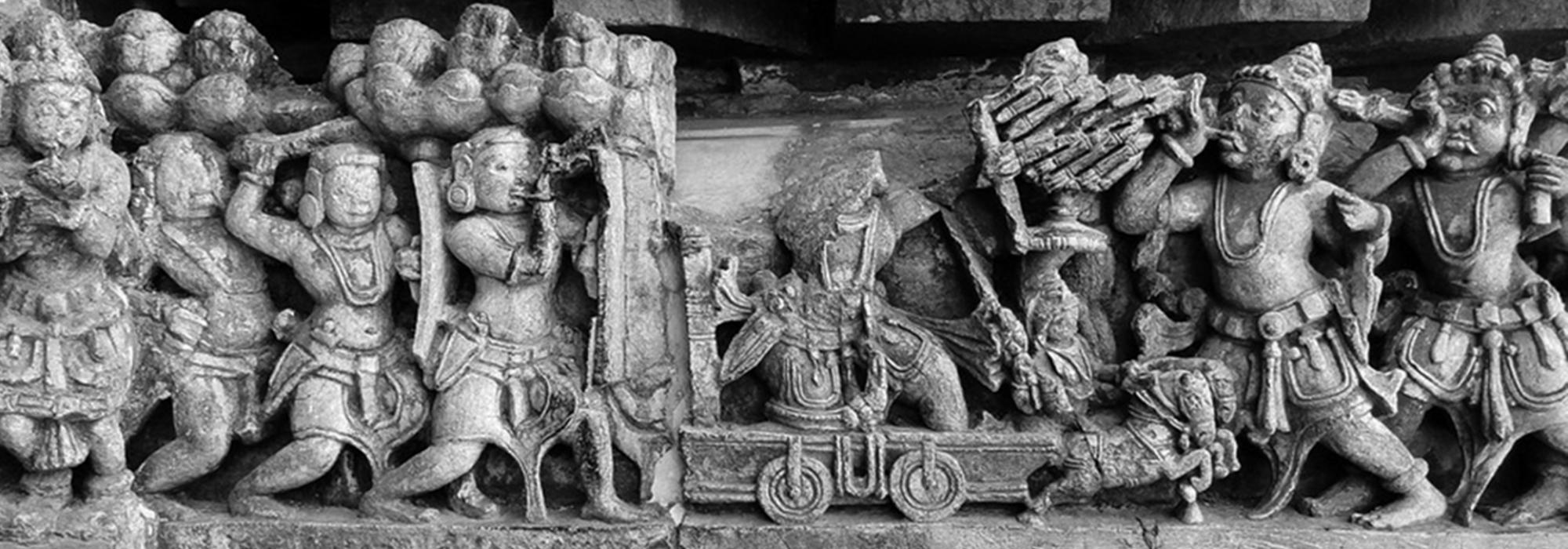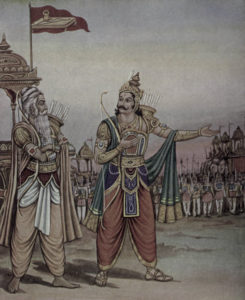Nearly 5,000 years ago in Kurukshetra in Northern India, the hundred sons of King Dhritarastra fought the famous Mahabharata war against the five sons of King Pandu, King Dhritarastra’s younger brother. The former group was called the Kauravas and the latter, the Pandavas. Almost all major kings from the Indian subcontinent took part in this great war that was fought for eighteen days. Although the Kaurava army was larger, the Pandava army finally won the war.
Arjuna was the third of the five Pandavas, known for his prowess in archery. He was a key player in the war. But moments before the war began, he felt undue sympathy towards his enemies because they comprised his teachers, relatives and friends, and he refused to fight. This kind of reaction from Arjuna was strange; it was a moment of insanity. Arjuna spent the greater part of his life honing his fighting skills and acquiring new weapons, knowing well that he would have to defend his people from the Kauravas, who were always plotting against them. He also knew that his teachers and revered elders would fight on the side of the Kauravas.
Arjuna did not walk away from the war, but was overcome with emotion and was unsure if it was the right decision to fight. And at that crucial point, Krishna, his long-time friend and mentor, spoke the Bhagavad-Gita to Arjuna in an attempt to cheer him up and clear his doubts.
In sum, Arjuna was confused whether he should take part in the war but Krishna asked him to fight. So the common questions that arise in our minds are: “Does the Bhagavad-Gita advocate war? Is it a violent scripture? Isn’t Arjuna making the right decision of going away from war? Shouldn’t Krishna have encouraged him to ‘show the other cheek’?”
If we dig deeper into the context of the Mahabharata war, we will find satisfactory answers to our questions.
Duryodhana was the eldest among the hundred Kaurava brothers and was known for his exploits with the mace. His childhood jealousies towards the Pandavas and his greed for power spurred him to plot against them.
Shakuni was the maternal uncle of the Kauravas and a mastermind. For Duryodhana’s sake, he orchestrated several devious schemes to trouble the Pandavas. One such instance was when he got the Pandavas invited to a game of dice and defeated them by deceit; it had been decided earlier that the loser of the game would forsake his kingdom, retire to the forest for twelve years and then live incognito for a year.
Having lost the game of dice, the Pandavas went into exile for thirteen years. When they returned, Duryodhana refused to return their kingdom as promised; he wanted a war to decide that.
The wise Yudhistira, eldest of the five Pandavas, pleaded for peace in the land of their ancestors1. When the Kauravas didn’t compromise, he finally asked for five villages to be given to the five Pandavas, and all would be forgotten. Duryodhana said in response, “Either I, killing the Pandavas, will rule over this kingdom or the sons of Pandu, killing me, shall enjoy this land. I will sacrifice everything but I can’t live side by side with the Pandavas. I won’t surrender to them even that much of land which is covered by the sharp point of a needle.”2
Krishna, an incarnation of the Supreme, was related to both the Pandavas and Kauravas. He did not want the dynasty to be destroyed and tried to broker peace between the cousins. He went to King Dhritarashtra’s assembly and said, “Joy in the happiness of others, sorrow at the sight of another’s misery – this has been the credo of the Kurus. Your race, O king, is so noble, that it will be a pity if its scion should do something so improper; and worse still if it were done by you. The evil Duryodhana’s misconduct will lead to universal slaughter. Please do something!”3
All the elders in the assembly and the counselors of Dhritarashtra told Duryodhana that the noble Krishna’s words were most appropriate for the situation and that peace was the best way forward.4
Duryodhana shouted in rage, “Why me? I have done nothing wrong! But as long as I live, the Pandavas will not get a share of the kingdom. Out of ignorance or fear, we had earlier given them the kingdom but now I will not give them even an inch of our land.”5
Krishna, with anger in his eyes, told Duryodhana, “If you want a war, then you shall have it. In a short time, there will be terrible slaughter. After so many devious acts, you claim that you have done nothing wrong! You are not willing to give them their share of the land even when they are begging for it! Ignoring the words of the wise and deriding the advice of friends, you can never achieve anything that is good. What you are set to do is dishonorable and sinful.”6
In an extreme fit of anger, Duryodhana tried to use violence against Krishna. A shocked Dhritarashtra tried to intervene. Krishna only said, “O king, if they wish to use violence, let them. On my part, I won’t do anything that will bring disgrace.”7
In response to the violence, Krishna merely showed a glimpse of his divine form to everyone present. Duryodhana left the place in a huff.8
“If war is what they want, let them have it. Now, with your permission, I will return.” So saying, Krishna calmly went out of the king’s assembly.9
The war had to be fought. Peace had lost.
Krishna’s advice to Arjuna to shed his cowardice and fight the war is in line with a simple practical rule that Krishna always followed – treat people the way they deserve to be treated. We can have peace between two groups that desire for peace. If one group is insistent on war, how can you counter that with peace? War and Peace are two sides of the same coin and we have to embrace both. We should know what is appropriate when. So, when peaceful negotiations are possible, it is inappropriate to fight, but when all options to broker peace have been exhausted, it is inappropriate not to fight.
Co-written by Hari Ravikumar
(This article first appeared in the April 2015 issue of Spark)
Endnotes
- The Mahabharata, Udyoga Parva (Book 5), Section 31
- Ibid., Section 58
- Ibid., Section 95
- Ibid., Section 96-126. Note that the narration of the attempts at peace cover more than 30 sections, while the Bhagavad-Gita has only 18 sections with just a few verses dealing with war.
- Ibid., Section 127
- Ibid., Section 128
- Ibid., Section 130
- Ibid., Section 131
- Ibid.
















































Comments